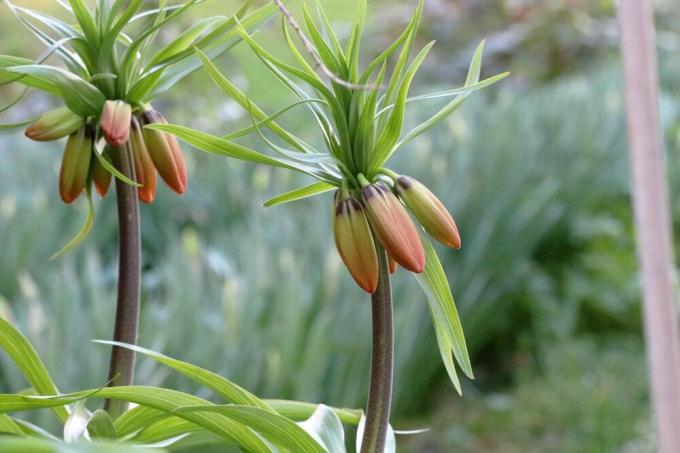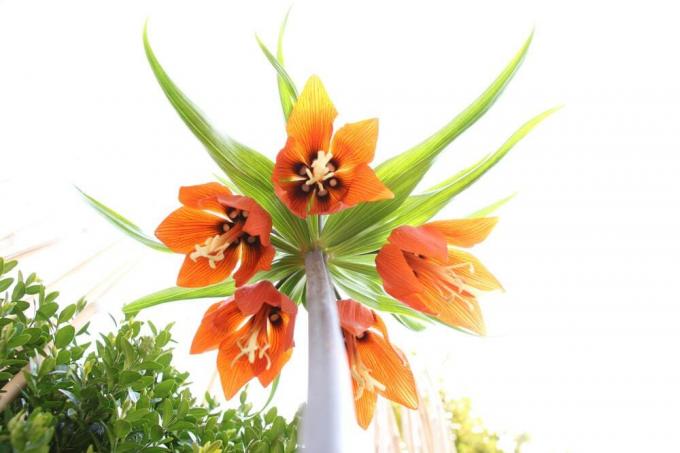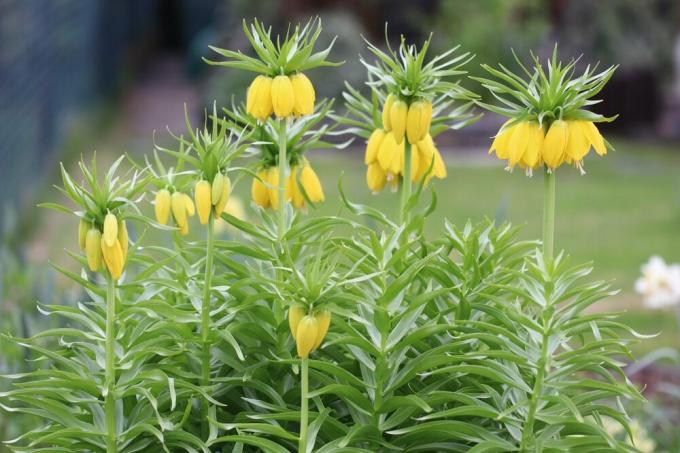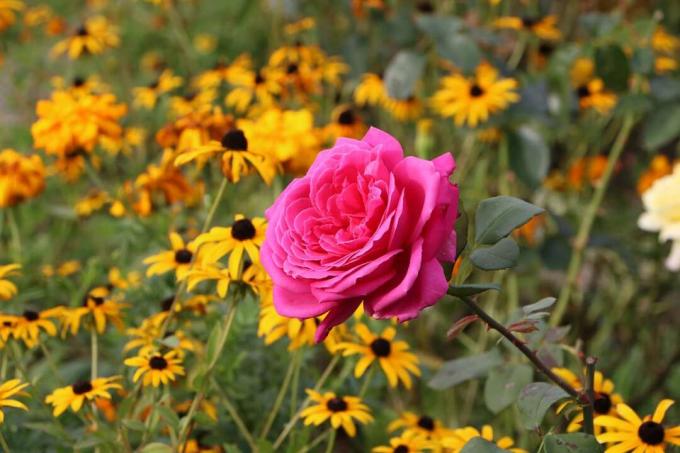

Table of contents
- The peculiarities of the imperial crown
- location claims
- Imperial crowns do not tolerate any competition
- Caution: Toxic
- Plant crown imperial
- Care of the imperial crown
- Increase imperial crown
- sowing and cultivation
- Separate and plant daughter bulbs
The imperial crown is one of the most expressive lily plants and can cause a stir in the garden. Unfortunately, "Majestät" seems to be aware of this fact and does not accept the first best - theoretically great - location. Once this hurdle is overcome, care is no longer difficult; However, the propagation can also demand some patience from the gardener:
The peculiarities of the imperial crown
The imperial crown belongs to the lily family and, like many members of this family (tulips, lilies, clintonia), develops striking, intensive flowers colored petals (in yellow, orange, red) - but not erect in the air or tilted elegantly to one side, but downward, like a crown upon one Stalk.
Also, these flowers do not appear on a normal stalk full of green leaves, but on a leafless stout absolutely straight flower stalk; and above the crown it is not the end either, but there grows a confused or elegant one depending on the variety "Struwwelpeter-Blattschopf" - the whole thing sometimes has something of science fiction and always something wrong World.
The flowers can be admired exceptionally early in the year: The earliest varieties in March, April is the main flowering time, at the end of May even the late varieties irrevocably wither. A breathtaking sight in the natural environment of Southeast Asian mountain regions and also an absolute highlight in the home garden. But so much splendor would also like a special treatment; Unfortunately, the Kaiserkrone is famous for a certain "bitchyness":
location claims
By far the most important thing about caring for the imperial crown is choosing a location that suits it. The picture of the imperial crown in its natural environment shows it clearly: it develops in a rather barren environment Persian, Afghan, Pakistani hill-bush landscapes long, strong stalks with growth heights of up to to 160 cm. These hill-bush landscapes are at altitudes between 1250 and 3000 meters and offer rocky subsoil rather than deep humus layers; but also a very good supply of minerals, a sloping position guarantees without waterlogging and lots of sun (which in other locations disappears behind the ridge for part of the day can).
These requirements look like this when applied to the garden:
- Fresh, loose garden soil, not necessarily overly nutritious
- Not particularly deep either, the bulbous plant bores itself into the depths over the years
- Sunny or shady (which means something like "bright penumbra)
- Moisture, just enough to get enough of the rain that flows past
- Thoroughly loosen compacted garden soil before planting imperial crowns
- If sand is mixed in, use/add rock flour containing minerals
- pH value: Optimally neutral (stony mountain soil, 6.6 - 7.5) or slightly alkaline (limestone soil, up to 7.8)
- Slightly acidic soil pH values up to a maximum of 6.1 are tolerated according to experience reports
If you fulfill all these needs of the imperial crown in the most exemplary way - you should be prepared for the fact that Fritillaria imperialis will not grow out immediately with full force, but
- blooms wonderfully in the season after planting, but never again afterwards (or until you have realized that "Your Highness" does not want to grow in this place and you are looking for a new place)
or
- accepts the location after some "sensitive posturing", but only shows its true splendor after many years.
Imperial crowns do not tolerate any competition

The bitchyness is due in large part to the fact that the mighty plant doesn't really tolerate competition in its location. There are reports online that the imperial crowns began to grow magnificently when the larger tree in the was removed from the vicinity and the few bushes growing a little further away were severely thinned out. After this clarification, it is no longer surprising that 2/3 of the imperial crown pictures show lonely heads floating in the air; the bare earth in the lower area is just not terribly photogenic. It is not uncommon for the imperial crown to end up in the unvegetated area in front of the fence after “attempt 7 at a location that is more in view”, where the conifers that are quite far away just about tolerate it.
Which competition the imperial crown does not like at what distance has not yet been conclusively researched; why imperial crowns sometimes do not get warm with actually very beautiful locations is not yet entirely clear. But you would do well to leave a group of well-growing Crown Imperials in place, even if the new lawn needs to be planted around them. If a location suits the Kaiserkrone, it stays true to it for a long time - reports on Imperial crowns that thrive in one location for over two decades and get more beautiful every year are not Rarity.
And the imperial crown is not against all competition either; e.g. B. they don't bother those of their own species next to them at all. If you keep a little distance, imperial crowns can even be planted in the middle of the garden (and mulched with the lawn clippings after flowering so that the bed does not look so bare). The imperial crown also gets along well with relatives (tulips are also a lily family). There are also said to be fast-growing annual summer flowers that crown imperials get along so well with, ask your nursery.
Caution: Toxic
The last point to note when choosing a location is that the crown imperial is poisonous in all parts of the plant. It does not belong to the most poisonous plants, these are henbane (Hyoscyamus niger), monkshood (Aconitum napellus), yew (Taxus baccata), Angel's trumpet (Brugmansia spec.), spotted hemlock (Conium maculatum), autumn crocus (Colchicum autumnale), castor bean (Ricinus spec.), Daphne species (Daphne spec.), thorn apple (Datura stramonium), tobacco (Nicotiana spec.), deadly nightshade (Atropa bella-donna) and water hemlock (Cicuta virosa).
Compared to these three-star poisonous plants (= intake of small amounts can lead to severe to fatal poisoning), Fritillaria imperialis appears comparatively harmless, because only the onion is given as the predominantly poisonous part of the plant and because it only has two “poison stars”. (www.giz-nord.de/cms/index.php/liste-giftiger-pflanzenarten.html). But the plants with two stars can also lead to "moderate poisoning if consumed in small amounts". They should therefore not stand directly in the way of digging dogs or "blind tasting" small children (which should also not taste weaker poisonous leaves).
However, only Kaiserkronen varieties whose smell you already know should be planted directly next to the seat; the scent of more original Kaiserkronen varieties is said to be able to disrupt the enjoyment of the cake.
Tip:
Kaiserkrone is often recommended "against voles". That is correct in that voles around the roots of classic imperial crowns because of an unpleasant smell and poison make a detour, so these imperial crowns can be planted around other crops as a protection against voles become. In addition to traditional cultivars ('Lutea Maxima', 'Rubra Maxima'), however, new, more delicate varieties have been bred that fit better in small home gardens and are therefore sold a lot. With these varieties called 'Beethoven', 'Vivaldi', 'Chopin', it is even recommended to plant them in wire baskets to protect against vole bites.
Plant crown imperial

Like all perennials, imperial crowns are best planted in autumn so that they can take root over the winter. If you get bulbs as early as August, you can grab it, then the bulb can root before root growth slows down in low autumn-winter temperatures. The more roots the imperial crown can form in the winter months, the stronger it can form flowers in the next season.
Planting works like this:
- Prepare well with a strong onion cutter
- Plant the bulbs 15-20 cm deep in the ground
- Without hurting the outer layers or the onion tart on the bottom
- Maintain a minimum distance of 20 cm (lower varieties) to 30 cm (tall varieties) between imperial crowns
- First put sand and humus in the hole that has been dug deep and wide enough
- Then the onion, press lightly and fill with soil, water, done
Of course, the imperial crown can also be sown because, like any plant, it can grow from seeds, Preparing your own imperial crowns by sowing and growing is not really recommended here become. You would need very fresh seeds because the seeds cannot be stored, the seeds have to be stratified in the cold to break the germination inhibition - and then you can simply wait a few years until the imperial crowns develop their first flowers (if they have been placed in a location that pleases). A project that will certainly please patient old gardeners more than young gardeners who are finding out about new flowering plants for their gardens.
Care of the imperial crown
If the Imperial Crown accepts a location, the bitchyness is over. The wondrous crown imperial transforms just as miraculously into a very easy-to-care-for plant that has no special needs:
- Freshly planted young plants need to be watered if the weather stays dry for a long time
- Older Crown Imperials can be left to their own devices until desert conditions prevail in the garden
- Preventing waterlogging is more important than watering
- The plant from the stony mountainous country does not need a lot of fertilizer either
- A few nutrients should be available, even the growth of the flower stalk consumes some energy
- During flowering, the need for nutrients increases
- A few nutrients more or less then make the difference between 1.20 m height and 1.60 m height
- But organic fertilizer please, preferably in March and in liquid form that is available relatively quickly
- The Kaiserkrone should react with a cold to just slightly incorrectly dosed doses of fast-acting mineral fertilizers
- A supply of minerals/trace elements is almost more important than a supply of main nutrients
- These are usually found in abundance in the soil in mountainous regions
- So keep scattering rock flour, which contains all the necessary soil minerals
- In the fall, the imperial crowns get an extra shot of potassium
- This helps the plant cells to mature before the cold season
This maturing also means that you leave the foliage of the imperial crown after the flower has faded and only remove it in the next spring just before it sprout. The bulbous plant absorbs nutrients from the leaves that are needed in winter.

The imperial crown has no problems with hibernation, it is hardy up to winter hardiness zone 5 (-28.8 °C average maximum minus temperature). The coldest regions of Germany belong to the warmer winter hardiness zone 6, average maximum minimum temperature -23.3 °C, which a Kaiserkrone can easily handle.
Tip:
Transplant, bring into the house for the winter? No way! Taking an Imperial Crown away from an accepted location is probably the best way to spoil her mood. If the location is not accepted, replanting must be dared, even daughter bulbs obtained from an old plant should often decorate new locations; but with both measures it can happen again that the imperial crown does not accept the new location If it does not have to be, an imperial crown should definitely be left in its original place until its end of life goes.
Increase imperial crown
sowing and cultivation
The disadvantages of growing imperial crowns have already been described above. Self-sowing in the bed can work under the following conditions:
- Several varieties of Kaiserkrone were planted side by side (Kaiserkronen hybrid varieties are often self-sterile)
- Your garden offers enough native, nectar-producing plants to attract enough pollinating insects
- The imperial crowns also flowered at the same time
- These insects include generalists who not only pollinate very specific plants
If you want to decorate other places in the garden with imperial crowns, you can of course also collect the seeds and sow them in other places. The seeds are very fine, they can best be removed if you collect the withered inflorescence with ripe seeds in a bag and get to the tricky work at the table and in peace. The seeds should then be sown immediately; However, when choosing a new location, keep this in mind: “Imperial blossoms” will only be able to be admired on the sown imperial crowns in a few years.
Separate and plant daughter bulbs

In the imperial crown, small daughter bulbs can form on the main bulb, which can be separated and replanted. Whether daughter bulbs really form depends on the breeding variety and the satisfaction of the imperial crown. Not every cultivar produces brood onions, especially new cultivars can have large, lazy onions. The plant can only cope with the production of offspring if it grows under ideal care conditions.
Sometimes you can see suspect that your crown imperial has formed small offshoots: If a crown imperial after a long period of satisfied growth (old varieties after decades, newer varieties, etc.) u after a few years) suddenly refuses to flower, this may be due to the many small daughter bulbs. These daughter bulbs weaken the mother bulb, which has to share nutrients with her offspring. They also tend to push the starting bulb higher and higher, which weakens it as well. Then the old plant can be dug up when the leaf stalk slowly yellows and falls over. The daughter bulbs are carefully separated and planted.
Water offshoots thoroughly and do not let them dry out until the next season. If the bulb of the old plant still looks plump and healthy, you can place this bulb on the spot and replant in place, sometimes removing the daughter bulbs acts like a makeover.
If you have come this far, it is time to deal with the 20 or so cultivars of the Kaiserkrone, which still have a few surprises in store – or even with the Fritillaria, this genus of the lily family has around 140 varieties to offer, many of which are used as ornamental plants become.
 garden editorial
garden editorial I write about everything that interests me in my garden.
Learn more about roses

What goes with roses: 30 beautiful rose companions
The beauty of roses really comes into its own when surrounded by the right companion plants. It is important for rose companions that they have similar requirements to roses. We tell you what goes well with roses.

Rose soil: mix soil for roses yourself | composition
The rose is considered the queen of flowers and she is very demanding. When it is newly planted, the soil should therefore be optimally prepared. Special rose soils are particularly suitable for planting. How to make them yourself is in this post.

Rose cuttings: 8 tips for propagating roses
Roses can be propagated quite easily with the help of cuttings if the site conditions and the preparation are right. Both the time and the care play an important role in ensuring that the rose shoot takes root successfully and then thrives magnificently.

Combat rose pests | 10 typical pests on roses
Roses are the pride of many ornamental gardens. But in addition to diseases, pests also give you trouble again and again. Anyone who knows how to recognize and fight them can easily and quickly protect their darlings from most dangers.

Rose care in spring | 5 tips for the new season
The rose, the queen of flowers, should not be missing in any garden! If you want to enjoy the blooming splendor of bedding, hedge and climbing roses in summer, you have to start caring for the roses in spring. We have put together the most important information for you.

Caterpillars and Bugs on Roses: Spotting 16 Common Pests
Roses, the queen of flowers, impress with a variety of species and varieties. Their care is easy to difficult. This is in the eye of the beholder. However, care mistakes are only a danger for roses, because they are also popular with numerous pests.



